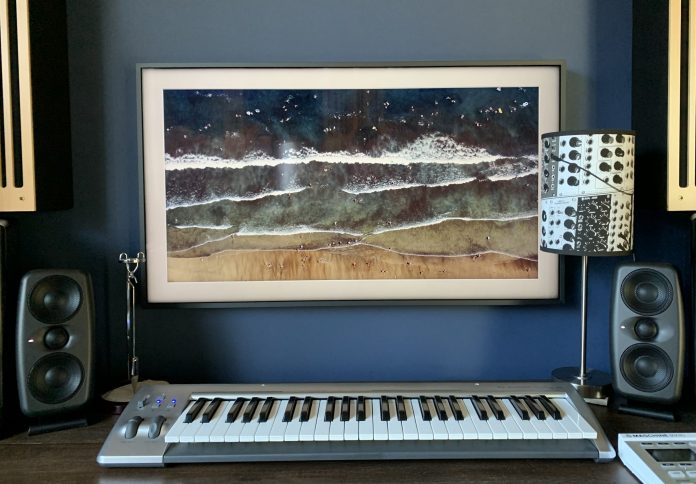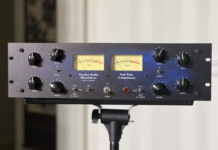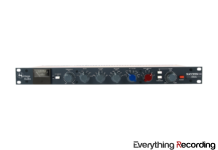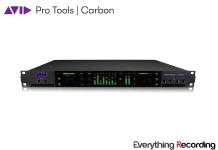- Include technology initially only available in very expensive speakers
- Small footprint lets you bring them anywhere
- Incorporate the ARC mic to help with common room issues.
- Not a con, but I wish they would push the DSP technology to model different speaker types
We’ve heard a great deal of hoopla surrounding IK Multimedia’s second edition in the iLoud series. Because seeing (hearing in this case) is believing, we wanted to know for ourselves if these studio monitors held up to the hype. The kind folks at IK Multimedia offered us a pair, and we quickly jumped at the opportunity. Let’s get to it.
Mobile
Although IK Multimedia began creating software, they quickly cornered the market on tools for the emerging mobile revolution. The iPad envisioned a world of compact portable recording and mixing – IK Multimedia brought it to life. Tools like the iRig series gave the musician on-the-go a link to interface instruments and mics to tablets. Shortly after the iRig series launched, IK discovered a missing link in the mobile experience – getting the music to your ears. Enter the iLoud, a Bluetooth speaker complete with a built-in iRig circuit for recording in the wild.
Micro
Ever the adventurous company, IK Multimedia created the iLoud Micro Monitor. These small desktop speakers introduce an additional reference to mix at home or abroad, all with a manageable footprint. Tackling the pitfalls of less-than-ideal mixing environments requires other solutions. The iLoud Micro Monitor features both an adjustable base and a threaded receptacle for mic stand mounting.
On top of the Bluetooth connection, this pair of compact desktop speakers adds RCA inputs, a 1/8th inch connection, and “Positioning EQs.” This series of buttons adds selectable high-frequency boosts, low-frequency dips, and a “Desk” mode which dips the mids to accommodate reflections from a desk and console.
MTM

The iLoud MTM (Midwoofer-Tweeter-Midwoofer) expands on the Micro’s practical use with a more sophisticated and robust design. IK Multimedia based the configuration on the D’Appolito design, where the tweeter is sandwiched between a pair of mid-woofers. The design is incorporated into many high-end speakers, and for the life of me, I don’t know why we don’t see more of this configuration. Bravo, IK Multimedia, for bringing it into a pair of monitors that I don’t have to sell my firstborn to buy.
What’s in the Box?
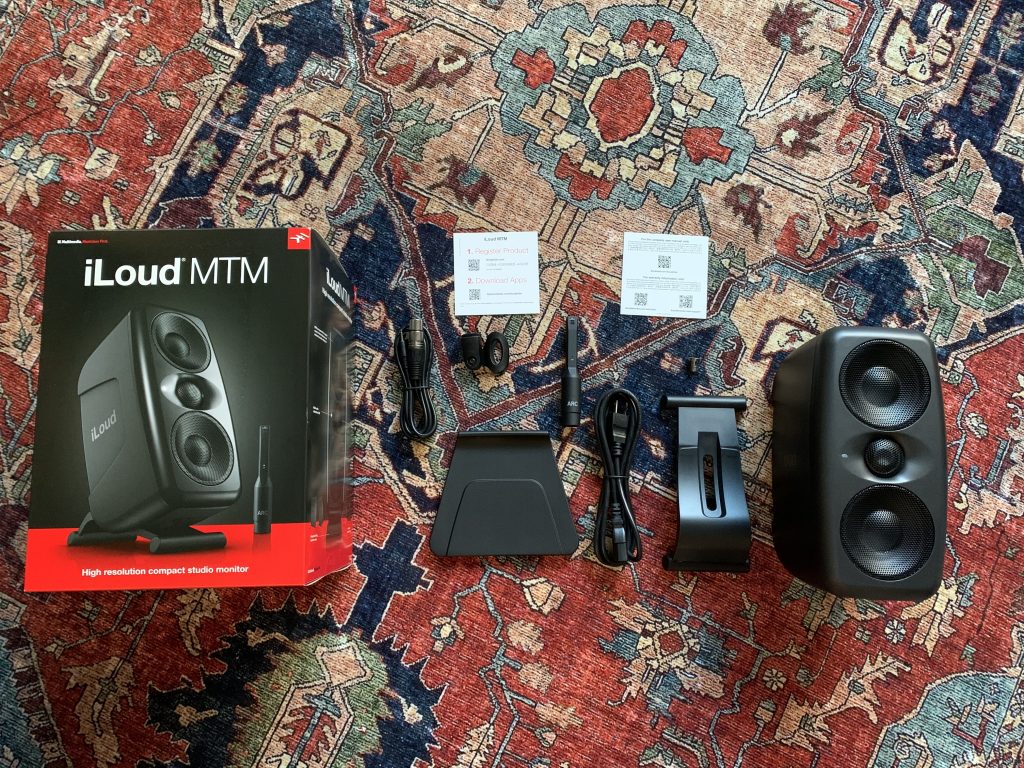
IK Multimedia realize there is no perfect setup. In the box, they’ve included most things to get you set up and calibrated. For positioning, you have the choice of orientation to fit your configuration. While IK recommends mounting vertically to utilize the controlled vertical dispersion, you can mount MTMs horizontally if space doesn’t allow it. For vertical mounting, you have an isolation base complete with angle marks on the bottom. These marks make setting both monitors to the same angle much less of a chore. If horizontal is your only option, the TPU bases supply isolation and stability to the rounded edges.

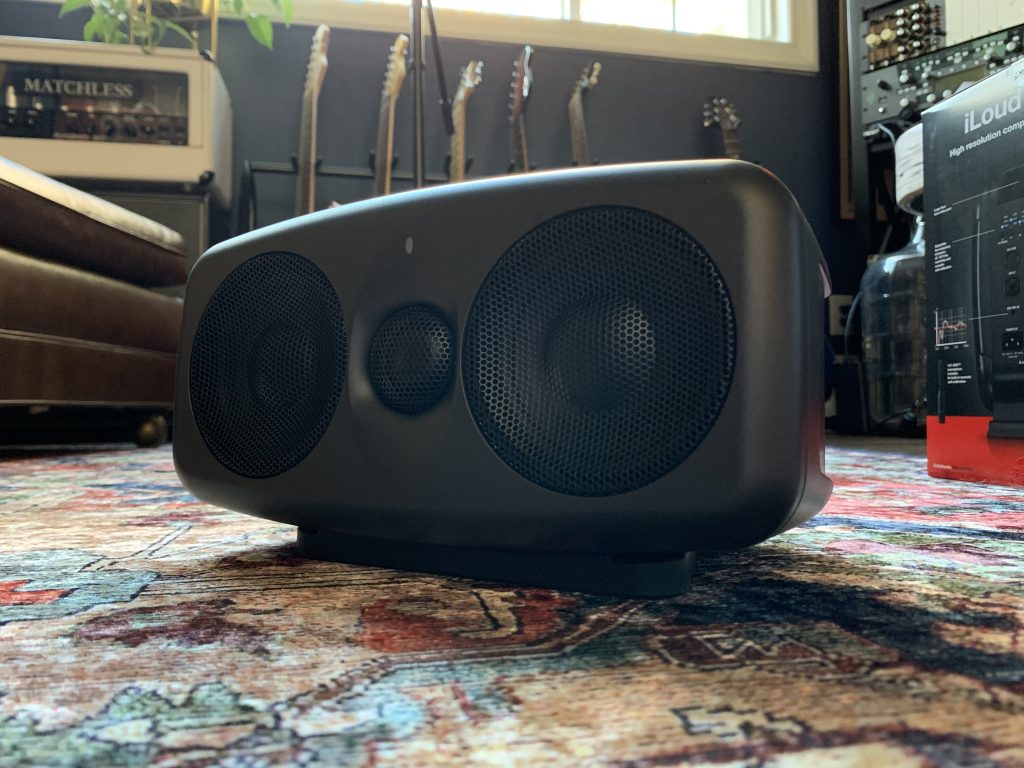
The box also includes the ARC Mic, complete with a mic clip and cable. In addition to the power cable, you have the registration card, complete with QR codes to get you where you need to be with registration and downloads.
Exterior
Of course, a bigger sound usually equals a bigger footprint, but the MTM still retains most of the same portability that made the Micros so appealing. You can even get a nice carrying case to bring them to other studios or that temporary mix area when the upstairs neighbors have finally had enough.
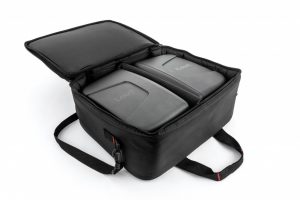
With portability being part of the charm, IK Multimedia knew they needed to balance weight and durability. They decided to go with molded plastic for the design, resulting in a sturdy feel, able to take the occasional ‘oopsie.’ We took them to several sessions (where people’s initial reaction was, “are those Genelecs?”), and they held up to the job with no issues. The exterior finish remained relatively unscathed, even without the use of a case or gig bag.
On the subject of finish, the MTMs have recently released a new sleek and stylish white edition. The bright glossy finish is perfect for breaking the monotony of space gray and black in the studio. While the look is eye-catching, I would recommend either the regular darker finish or the custom iLoud MTM travel bag if planning to travel with them. White tends to bring out the battle scars. Don’t believe me? Look at any MacBook charger after just a week with the plastic off.
One of These Things is Not Like the Other
Upgrades abound from the Micro Monitor’s original design. Expanding on Micro’s Ported 3″ woofer and 3/4″ tweeter, MTM adds two 3.5″ composite woofers with a 1″ back chambered loaded tweeter. This symmetrical stacked design creates controlled dispersion, which can help with poor room acoustics and imaging. To make heads bob harder, MTM ups the Micro’s 50W RMS to 100W, with 70w going to the LF and 30w going to HF. Combine these clean Class D amplifiers with IK Multimedia’s new Physical Response Linearization (PRL) and iLoud MTM claims to rival speakers twice MTM’s size.
A Trip Around back
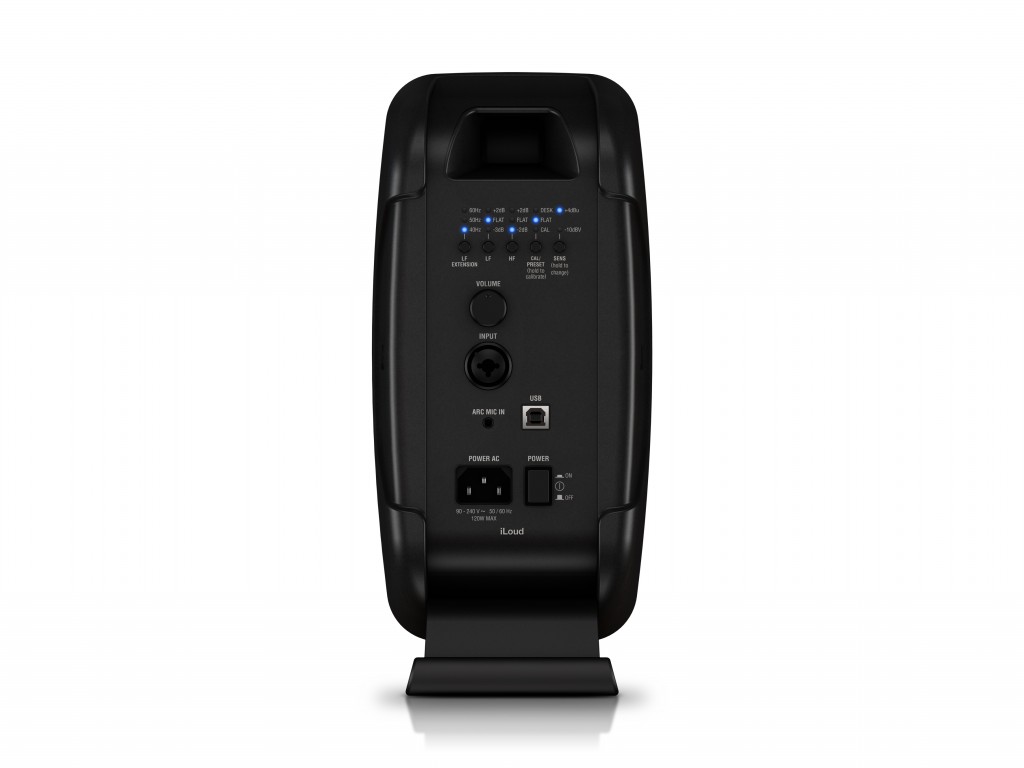
Not only does iLoud MTM utilize more speakers and power, but it also has more options. IK Multimedia have supercharged the back panel with more buttons to make your mixes translate to the fullest.
Drop it. Drop it Low
While IK Multimedia stays pretty tight-lipped about the LF Extension button’s inner-workings, we suspect this button calls on their new “Physical Response Linearization” along with real-life measurements to model the enclosure’s impulse response. With a precise representation of sonic behavior inside the enclosure, IK Multimedia can utilize the internal DSP to enhance a particular frequency’s properties, all in real-time. LF Extension has three settings, 40Hz, 50Hz, and 60Hz.
Instead of solely offering a boost for the highs and a cut for the lows, MTM assumes you know what you want. In addition to the flat setting, the LF button offers either a +2dB boost or a -3dB cut from 100Hz down. Similarly, the HF does the same thing, supplying a +2db boost and a -2dB cut from 8kHz up.
Curves for Days
Improving on iLoud Micro Monitor’s “Positioning EQs,” MTM adds a CAL option. Utilizing the included ARC microphone and the ARC Mic input on the back, you can individually calibrate speakers to their position in the room. This feature borrows on IK Multimedia’s ARC System, but instead of applying a correction to the speakers externally, iLoud MTM stores the calibration onboard. While this is not a new feature in studio monitors, it certainly is in monitors at this price point.
This is a Setup
Installation is as simple as it gets – and if you can’t figure this out, it might be time to re-evaluate your goals! For input options, iLoud MTM swaps the Bluetooth, RCA, and 1/8″ connections for a more-assuring 1/4″ / XLR combo input. IK Multimedia recommends initially updating the firmware when installing. This could be a problem if you don’t have a USB cable because the box doesn’t include one. On a side note, I don’t quite understand why these are sold as single units instead of by the pair, and instead of being stuck with two mics from buying individually, you get a USB cable. I would bet a USB cable is much cheaper than an ARC mic, so… win-win.
Positioning is vital with these monitors, and IK Multimedia stresses that you should point the tweeter at a straight line to your ears. Whether you use the tilt bases, mic stand mounts, or horizontal mounts, you must do everything you can to line the tweeter up with your listening position. Additionally, you will want to keep the speakers around eight inches from the wall and angled in the typical equilateral triangle configuration from the listening position to your ears. For the angle issue, I recommend the AudioApps Speaker Angle app.
Stop, Recalibrate, and Listen
Now, you have cables attached and monitors precisely facing those moneymakers on the side of your head. What now? Well, now we get to calibrate. Locate the power button on the rear and turn on the speakers (without moving them from their set positions). Carefully insert the ARC mic cable into the back of one of the speakers (again, without moving them from their set position) and place the ARC mic right at the tip of the triangle you’ve made between you and your speakers. Make sure you orientate the mic correctly (as seen in the picture below) and place it level with the tweeters. Now, (you guessed it, without moving the speakers), find the CAL/PRESET button and press it for two seconds.
By now, you’ve seen a recurring pattern. I wish IK Multimedia would have placed the crucial buttons on the side for easier access. If you’re setting up in your studio permanently, this won’t be as much of a problem. If you take the monitors on the go, you can avoid the “studio yoga” of contorting around the desk by gently tilting the monitors forward to access the back panel. The grip of the vertical base will stay in place, keeping your precise position.
Once you’ve held the CAL/PRESET button for two seconds, you have five seconds to get your human-bass-trapping-self out the way of the speakers and let the iLoud MTM do its thing. Calibration is quick, only taking around 5 seconds for a tone sweep. The LEDs on the front of the speaker will flash blue during calibration and green once complete. Don’t forget, that’s just one monitor done; you’ll need to repeat the same steps for the other speaker.
Up and at ‘Em
The setup and calibration were surprisingly quick and easy. I was honestly expecting a more time-consuming room measurement process as we had during the Sonarworks review. Still, IK Multimedia has made this easy enough for my wife to do (which I then had her repeat after I returned from using them in another studio). So, if my wife, who wants nothing to do with technology, can do it, anyone can.
So, How Do They Sound?
I knew that there was a lot of hype to these speakers going into this review, which naturally makes this beleaguered journalist very skeptical. I read thousands of press releases and hundreds of manuals every year. Certain words and repetitions of praise send my spidey sense tingling. I know some of these words are inevitable when describing products, but when you see the same old “consumerspeak” trotted out, it puts your guard up. Also, being ever the stodgy “older guard,” I don’t really want an extra layer of A/D conversion and silicon between my output and ears. Call it placebo, but I suspect I can usually “hear” processing in speakers with this technology.
In the case of the iLoud MTM, the marketing rings true. These speakers are everything IK Multimedia claims. I welcome the processing and can accept the DSP as a necessary evil in coaxing out the most performance from these admittedly tiny dancers. I’m not sure if I can hear what I usually think I hear, but I don’t care even if I did. I absolutely love these speakers.
In Use
When first throwing my usual cavalcade of “old faithfuls” through the iLoud MTMs, I was blown away at the dimension in these smaller speakers. The low end of these monitors will have you looking under the desk, looking for where IK Multimedia snuck a subwoofer in while you weren’t looking. The bass extension presents bass, not only in an enjoyable way but in an informative way. I switched between the calibration and flat and instantly noticed a precision in the stereo field. I repeated this in both treated and untreated environments, and the results were the same each time.
You can make decisions much quicker due to iLoud MTM’s pristine sound. Vocals instantly reveal their shortcomings due to the clarity in the mids and highs. I especially like the low-mid capacity these speakers have. I found my mixes’ fullness coming out more due to having the right information at my fingertips. As for the low-end, I’m thoroughly impressed. While I liked the 40Hz bass extension for listening, I found 50Hz to be a better fit as it seemed quicker in response.
Perfection – The Ultimate Myth
I have very few issues with the iLoud MTMs. Already having the power button in the rear is an inconvenience, especially given that monitors are the “last on, first off” in the studio, but the button blends with the speaker’s back when in the “on” position. This tactile camouflage makes powering off an affair of blindly swiping your finger around the rear of the speaker, risking moving your monitors from their configured place. The same goes for using the ARC mic and calibrating the speakers to the room. I wish the more used buttons and ARC mic connection were in an easier-to-find spot. I entirely understand maintaining a sleek design, and IK has mitigated this as best as possible with the base’s design – allowing the speaker to tilt forward without disturbing the position too much.
The only other recommendation is to push the Physical Response Linearization. If you’ve put DSP in a speaker that can apply impulse response to extend the bass, it seems you could easily incorporate different types of speakers for reference. Something similar to the Barefoot Footprint’s MEME technology. It would be great to have the ability to emulate a pair of NS10’s or even a cell phone speaker.
In Conclusion
I can’t say enough about how much I love these monitors. The stereo imaging is excellent, mixes translate much better, and music (whether referencing or only experiencing) is genuinely more enjoyable through them. The amount of informative low-end iLoud MTMs put out is staggering. These speakers translate audio better than just about any monitor in its price range and even beyond. Everything Recording HQ has a pair of Focal Solo 6 Be speakers, and as time went on, I found myself leaning more on the iLoud MTMs. Don’t get me wrong, I love pulling the top back and cranking the Focals toward the end of a session, but the iLouds feel more utilitarian, exposing flaws in tracks.
Combine the portability, built-in calibration, and extraordinary translation, iLoud MTM just might quickly become your desert island studio monitor.



